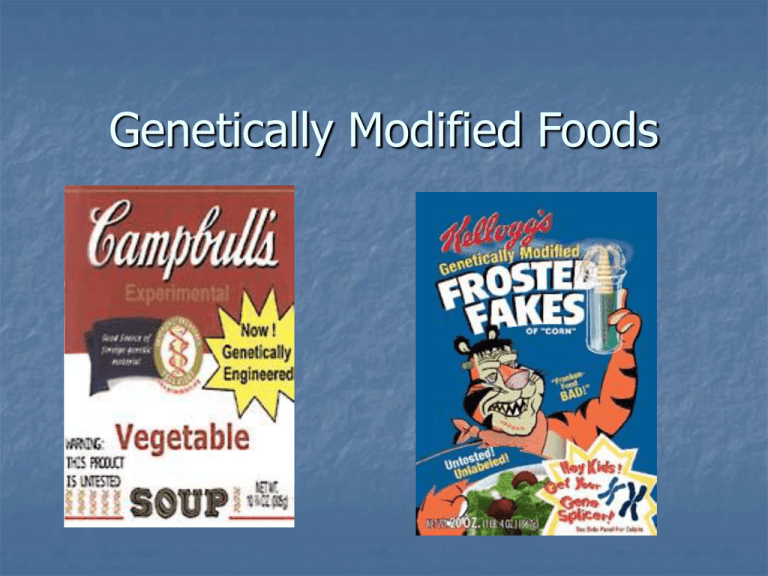Genetically Modified Organisms
advertisement

Genetically Modified Foods What are GM’s? are a result of technology that has altered the DNA of living organisms (animals, plants or bacteria) Other terms that mean the same thing: Genetically engineered Transgenic Recombinant DNA (rDNA) technology How does this differ from Mendel and his peas? GM vs. Selective breading Selective breading -slow -imprecise -modification of genes that naturally occur in the organism GM -very fast -precise -can introduce genes into an organism that would not occur naturally! Why do it? Rice- not high in essential nutrients Modification: + daffodil genes and a bacterium = betacarotene content drastically increased + genes from a french bean = double the iron content. Tomatoes- Introduce genes to increase shelf life. How is this done?: Transgenic tomatoes Other applications Potato - modified to produce a beetle killing toxin Yellow squash – modified to contain to viral genes that resistant the most common viral diseases Develop foods that contain vaccines and antibodies that offer valuable protection against diseases such as cholera, hepatitis, and malaria Canola – modified to resist one type of herbicide or pesticide A Local Example: : GM Canola Canadian-Australian Relations Bayer CropScience produces genetically modified canola in Australia for the Canadian market. It is produced to resist the herbicide “Liberty” and can yield up to 20% higher than conventional canola. Benefits of Genetic Engineering and Modifying 1. Higher yielding crops, more efficient use of land 2. Can save money and promote higher profits 3. Longer shelf life, less waste Example// Tomatoes from genetically modified seeds stay fresh longer. 4. Enhanced taste and quality 5. Reduced maturation time Benefits of Genetic Engineering and Modifying 6. 7. 8. 9. Increased and improved nutrients and stress tolerance - A single gene genetically engineered into cauliflower can increase production of beta-carotene 100 times. - A gene can be implanted into a soybean upgrading the soy protein to a quality equal to that of milk. - Corn can be modified to contain its two limiting amino acids, lysine or tryptophan Improved resistance to disease or illness - Foods can be enhanced with phytochemicals that help maintain health and reduce the risks of chronic disease. Improved crop resistance to disease, pests, weeds and herbicides New products and growing techniques - “Individuals allergic to milk may be able to buy milk that has been treated with the lactase enzyme” (Whiney, 2002). - Creating decaffeinated coffee beans are in a process of research. Benefits of Genetic Engineering and Modifying Society Increased food security for growing populations and growth challenges (Human Genome Project Information (2003), http://www.ornl.gov/sci/techresources/Hu man_Genome/elsi/gmfood.shtml) Who Uses this technology The Countries that Grow 99% of the World's Transgenic Crops 7% 1% USA 23% Argentina Canada 69% China Risks associated with Genetic Modification Safety 1. Potential human health implications. Potential environmental impact. Out-crossing 2. Inevitable out-crossing of transgenic plants with naturally occurring ones. Creation of super-weeds Creation of biological weapons. Access and Intellectual Property Domination of world food production by a few companies and developing countries. Risks associated with Genetic Modification – cont. 3. Ethics 4. “Playing God” Tampering with nature by mixing genes among species. Labeling 5. Not mandatory in some countries (e.g., Canada and the United States). Mixing GM crops with non-GM confounds labeling attempts. Society New advances may be skewed to the interests of rich countries. (Human Genome Project Information (2003), http://www.ornl.gov/sci/techresources/Human_Genome/elsi/gmfood.shtml) Risks with GM continued: Biodiversity Addition of Bt gene into plants including corn, potatoes and cotton to increase resistance to plants Bt gene obtained from Bacillus thuringiensis (a soil bacterium that produces a natural insecticide) Problem: plants producing Bt toxin are releasing toxin in pollen Draper, D. (2002). Our Environment: A Canadian Perspective 2nd Ed. Scarborough: Thompson Canada Lmt. Pollen from a Bt plant was dusted on to milkweed: - only 56% of young monarch butterfly larvae lived - whereas pollen from organic plants dusted on the milkweed produced a survival rate of 100%. Approximately half of the monarch butterfly population live in the “corn belt” of the USA = this new gene could have serious repercussions for this organism Canadian Food Inspection Agency Genetically modified foods are currently regulated by the CFIA works collaboratively with Environment Canada, Health Canada, and Fisheries and Oceans Goal: to ensure that products of biotechnology are considered safe to human and animal health and the environment. According to the CFIA, the assessment process for GE foods is very rigorous Canadian Food Inspection Agency Assessment process Criticisms of process Conclusion Genetic Modification: or ? Literature Cited: 1. Canadian Food Inspection Agency. Novel Foods Retrieved April 1, 2002, from the World Wide Web: http://www.inspection.gc.ca/english/plaveg/pbo/pbobbve.shtml 2. Canadian Food Inspection Agency.(2000) Plant Health and production division, plant biosafety office on Regulatory directive 2000-07: Guidelines for the environmental release of plants with novel traits within confined field trails in Canada. Retrieved April 4, 2002, from the World Wide Web: http://www.inspection.gc.ca/english/plaveg/pbo/dir/dir0007e.shtml 3. Draper, D. (1998). Our Environment: A Canadian Perspective 1st Ed. Scarborough: Thompson Canada Lmt. 4. Draper, D. (2002). Our Environment: A Canadian Perspective 2nd Ed. Scarborough: Thompson Canada Lmt. 5. Jones, L. (1999, February 27). Genetically modified foods. British Medical Journal. [Journal, Online]. Retrieved April 1, 2002, from the World Wide Web: http://www.findarticles.com/cf_0m0999/7183_318/5417903/print.jhtml 6. Health Canada. Retrieved April 1, 2002, from the World Wide Web: http://www.hc-sc.gc.ca/food-aliment/mh-dm/ofb-bba/nfiani/e_novel_foods_and_ingredient.html 7. Health Canada. A Bureau of Food Policy Integration (Food Directorate) Response to: Food Safety of GM Crops in Canada: toxicity and allergenicity: Retrieved April 5, 2002 from the World Wide Web: http://www.hcsc.gc.ca/food-aliment/mh-dm/ofb-bba/nfi-




